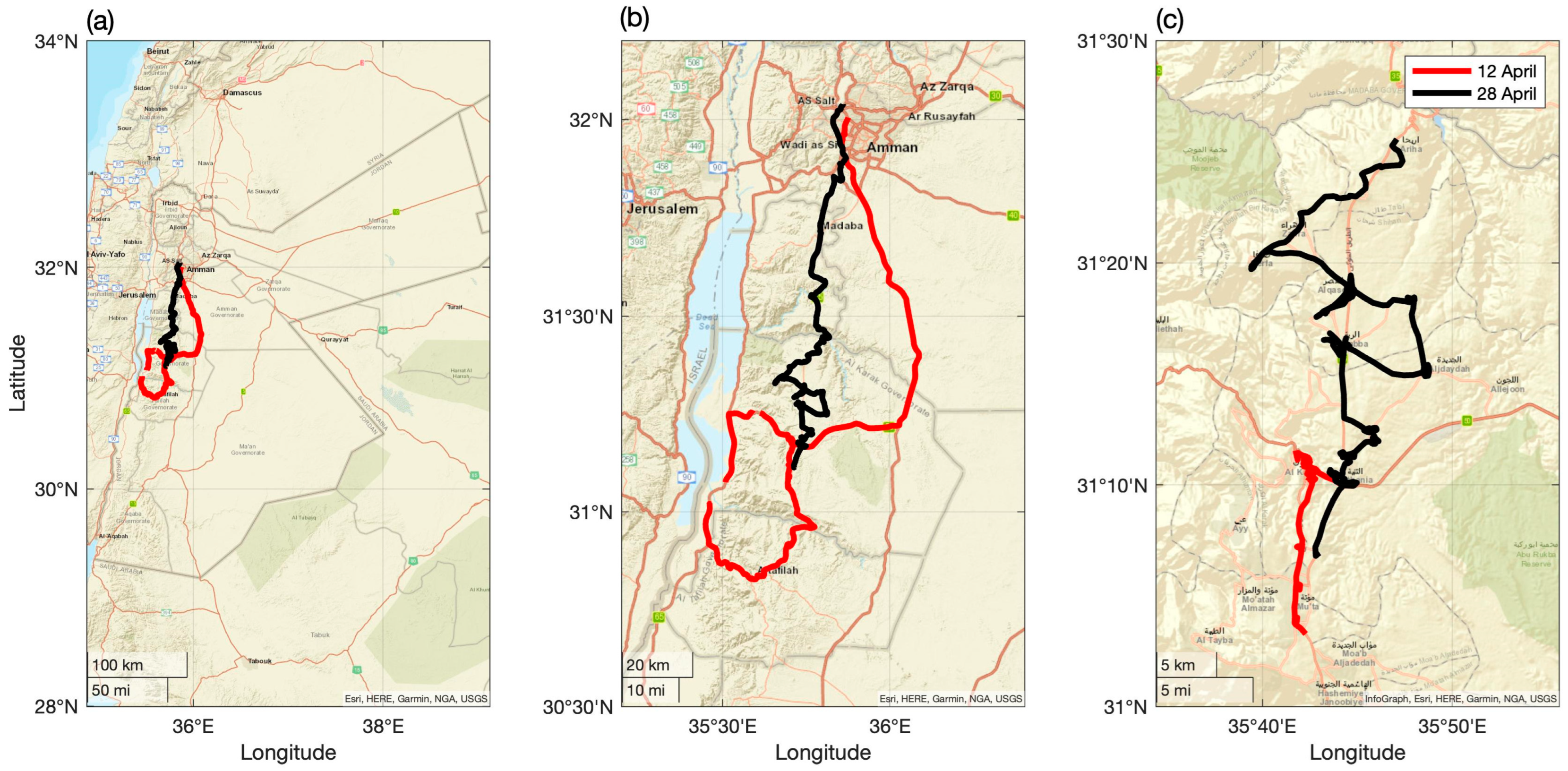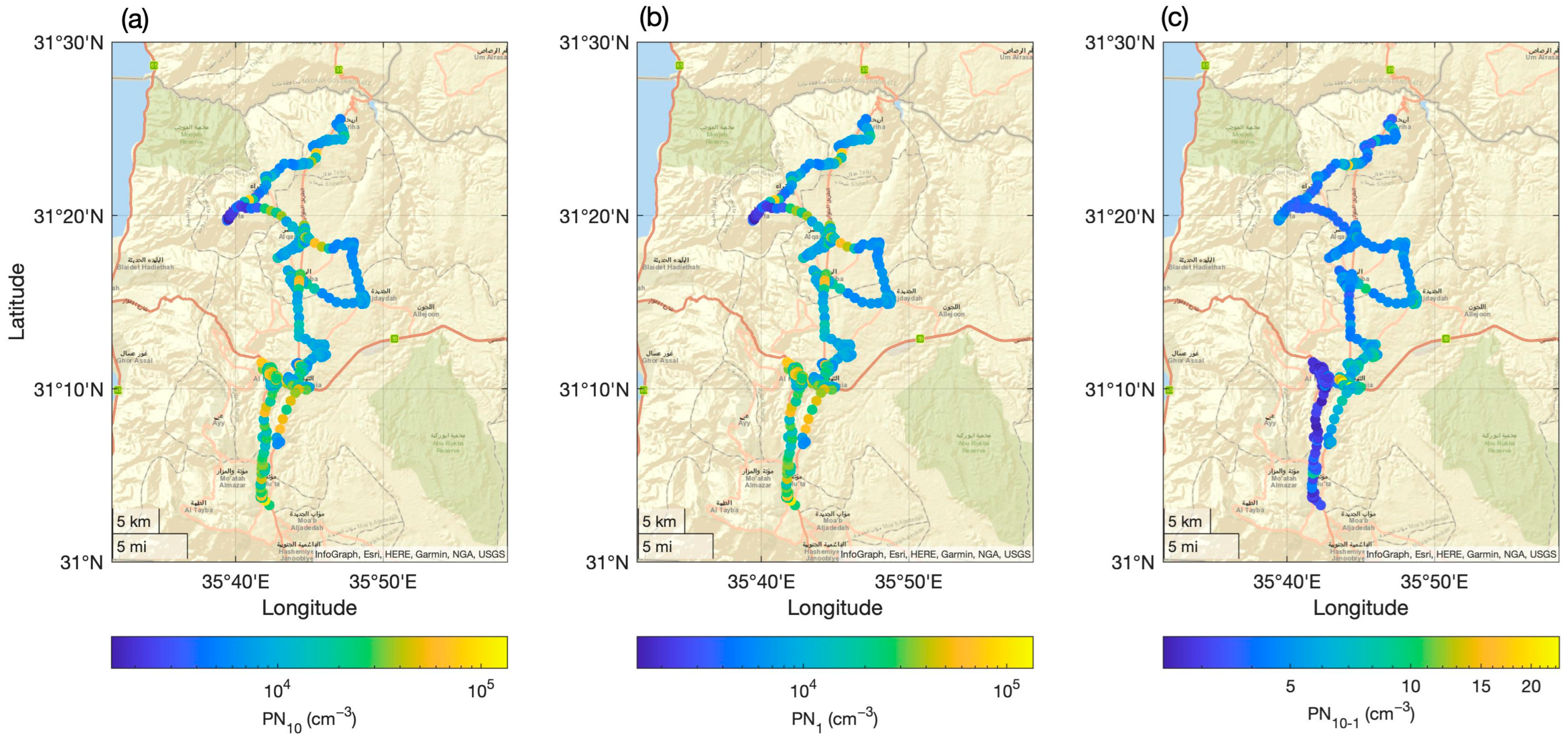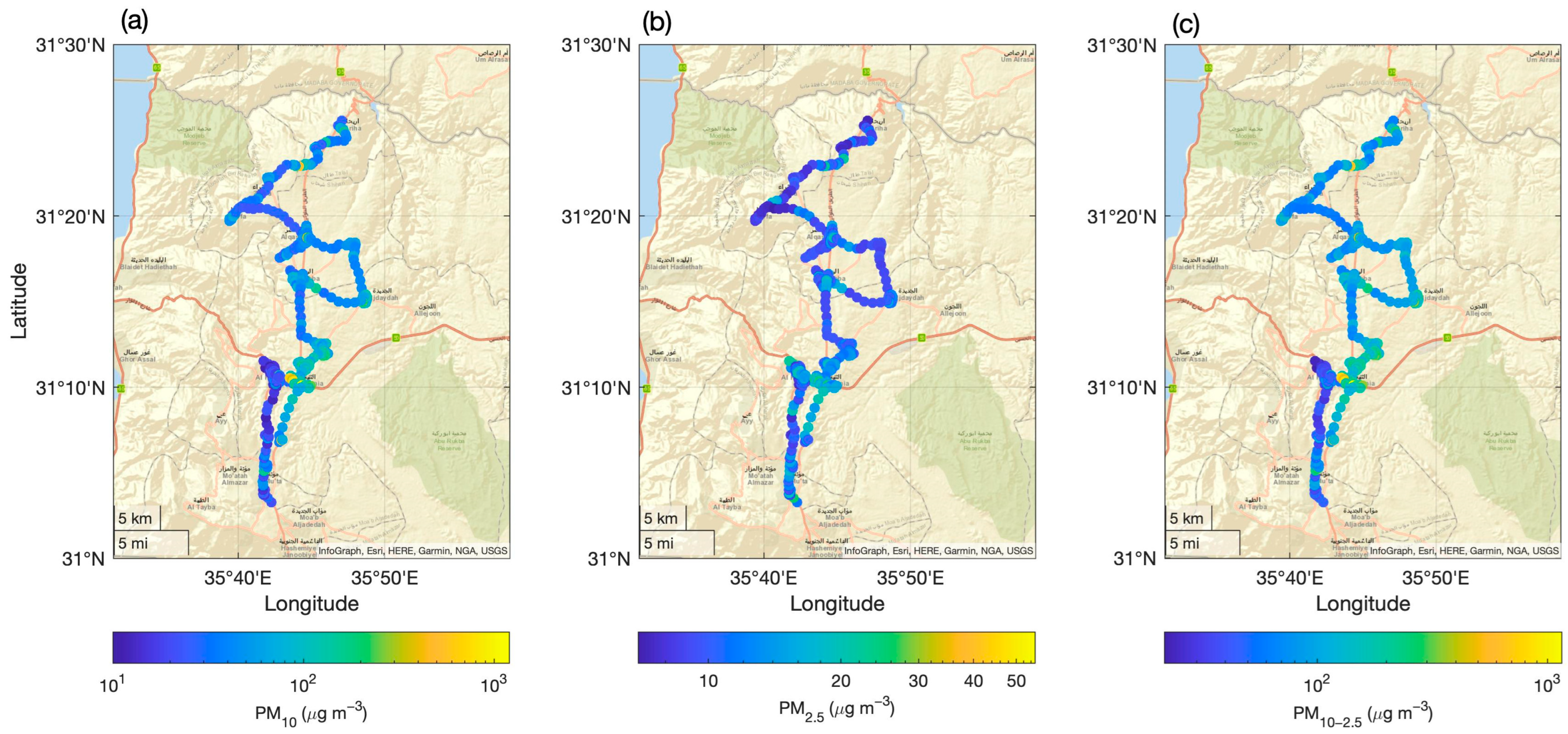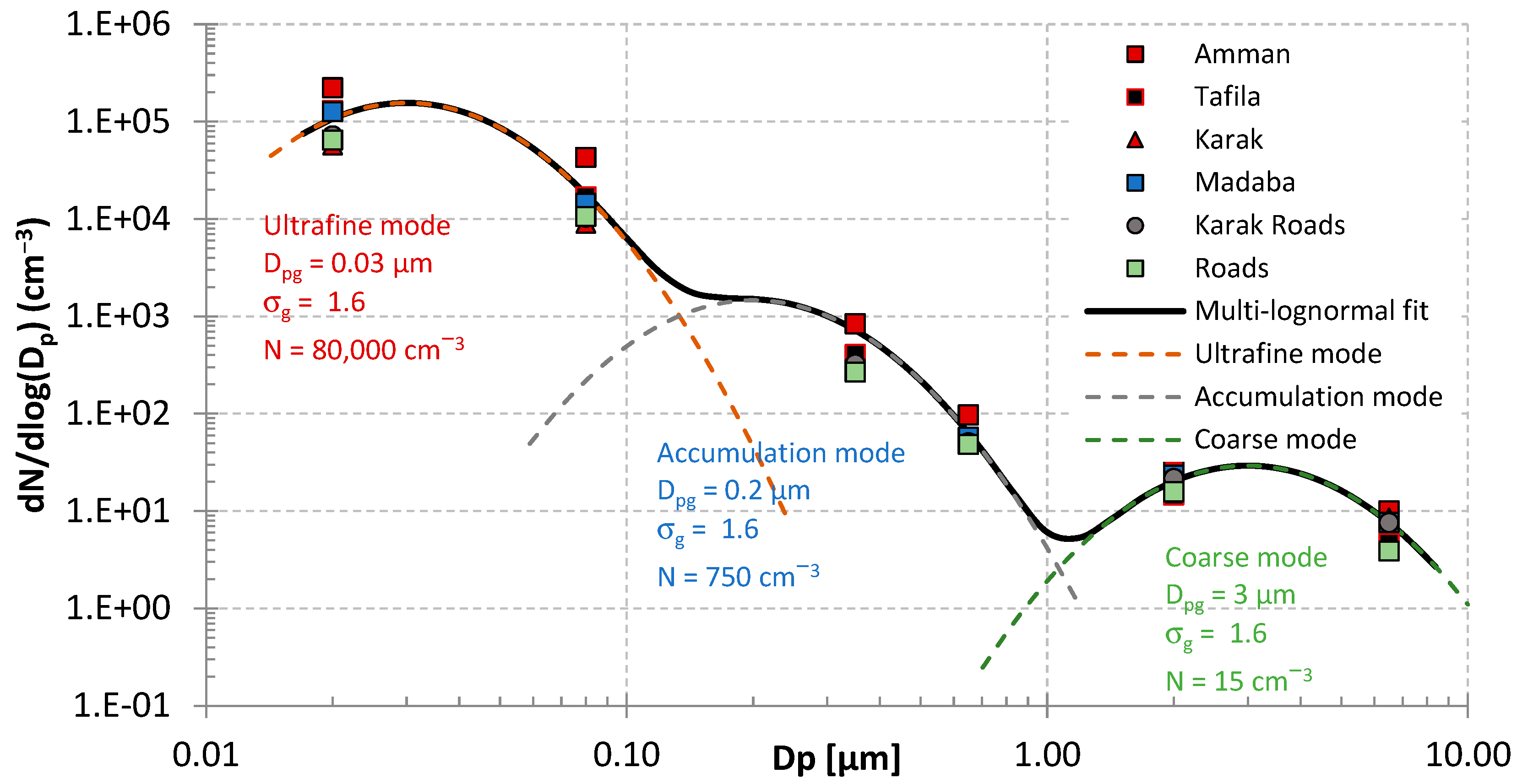Size-Fractionated Particle Number and Mass Concentrations in Karak Governorate and Neighboring Regions in Mid-West Jordan
Abstract
1. Introduction
2. Materials and Methods
2.1. Site Description
2.2. Description of the Measurement Campaign
2.3. Mobile Experimental Setup
2.4. Aerosol Data Handling
- (1)
- Periods spent crossing each city;
- (2)
- Periods spent on the main roads between cities.
- 10–25 nm (calculated from the difference between the concentrations measured with the CPC and the P-Trak).
- 25–300 nm (calculated from the difference between the concentrations measured with the P-Trak and the AeroTrak).
- 0.3–0.5 µm, 0.5–1 µm, 1–2.5 µm, 2.5–5 µm, 5–10 µm, and 10–25 µm. The last six particle size channels were measured directly with the AeroTrak.
2.5. Weather Conditions
3. Results
3.1. Short Summary About the Concentrations in Amman, Karak, Tafila and Main Roads
3.2. Particle Number Concentrations over Different Tracks in Karak
3.3. Particulate Mass Concentrations over Different Tracks in Karak
3.4. Particle Number Size Distribution (PNSD)
4. Discussion
5. Conclusions
Supplementary Materials
Author Contributions
Funding
Institutional Review Board Statement
Informed Consent Statement
Data Availability Statement
Acknowledgments
Conflicts of Interest
References
- Chen, R.; Hu, B.; Liu, Y.; Xu, J.; Yang, G.; Xu, D.; Chen, C. Beyond PM2.5: The role of ultrafine particles on adverse health effects of air pollution. Biochim. Biophys. Acta Gen. Subj. 2016, 1860, 2844–2855. [Google Scholar]
- Fenger, J. Urban air quality. Atoms. Environ. 1999, 33, 4877–4900. [Google Scholar]
- Samet, J.M.; Dominici, F.; Curriero, F.C.; Coursac, I.; Zeger, S.L. Fine particulate air pollution and mortality in 20 US cities 1987–1994. N. Engl. J. Med. 2000, 343, 1742–1749. [Google Scholar] [CrossRef] [PubMed]
- Pope, C.A., 3rd; Burnett, R.T.; Thun, M.J.; Calle, E.E.; Krewski, D.; Ito, K.; Thurston, G.D. Lung cancer, cardiopulmonary mortality, and long-term exposure to fine particulate air pollution. JAMA 2002, 287, 1132–1141. [Google Scholar]
- Curtis, J.R.; Westfall, A.O.; Allison, J.; Bijlsma, J.W.; Freeman, A.; George, V.; Kovac, S.H.; Spettell, C.M.; Saag, K.G. Population-based assessment of adverse events associated with long-term glucocorticoid use. Arthritis Care Res. 2006, 55, 420–426. [Google Scholar] [CrossRef]
- Vinzents, P.S.; Moller, P.; Sorensen, M.; Knudsen, L.E.; Hertel, O.; Jensen, F.P.; Schibye, B.; Loft, S. Personal exposure to ultrafine particles and oxidative DNA damage. Environ. Health Perspect. 2005, 113, 1485–1490. [Google Scholar] [PubMed]
- Krewski, D. Evaluating the effects of ambient air pollution on life expectancy. N. Engl. J. Med. 2009, 360, 413–441. [Google Scholar]
- Lepeule, J.; Laden, F.; Dockery, D.; Schwartz, J. Chronic exposure to fine particles and mortality: An extended follow-up of the Harvard six cities study from 1974 to 2009. Environ. Health Perspect. 2012, 120, 965–970. [Google Scholar] [CrossRef]
- Burnett, R.T.; Pop, C.A., III; Ezzati, M.; Olives, C.; Lim, S.S.; Mehta, S.; Shin, H.H.; Singh, G.; Hubbell, B.; Brauer, M.; et al. An integrate risk Function for estimating the global burden of disease attribute to ambient fine particulate matter exposure. Environ. Health Perspect. 2012, 122, 397–403. [Google Scholar]
- Lohmann, U.; Feichter, J. Global indirect aerosol effects: A review. Atmospheric Meas. Tech. 2005, 5, 715–737. [Google Scholar]
- Akinyoola, J.A.; Oluleye, A.; Gbode, I.E. A Review of Atmospheric Aerosol Impacts on Regional Extreme Weather and Climate Events. Aerosol Sci. Eng. 2024, 8, 249–274. [Google Scholar]
- Myhre, G.; Samset, B.H.; Schulz, M.; Balkanski, Y.; Bauer, S.; Berntsen, T.K.; Bian, H.; Bellouin, N.; Chin, M.; Diehl, T.; et al. Radiative forcing of the direct aerosol effect from AeroCom Phase II simulations. Atmos. Chem. Phys. 2013, 13, 1853–1877. [Google Scholar]
- Haywood, J.; Boucher, O. Estimates of the Direct and Indirect Radiative Forcing Due to Tropospheric Aerosols: A Review. Rev. Geophys. 2000, 38, 513–543. [Google Scholar]
- Boman, J.; Shaltout, A.A.; Abozied, A.M.; Hassan, S.K. On the elemental composition of PM2.5 in central Cairo, Egypt. X-ray Spectrom. 2013, 42, 276–283. [Google Scholar]
- Rushdi, A.I.; El-Mubarak, A.H.; Lijotra, L.; Al-Otaibi, M.T.; Qurban, M.A.; Al-Mutlaq, K.F.; Simoneit, B.R.T. Characteristics of organic compounds in aerosol particulate matter from Dhahran city, Saudi Arabia Arab. J. Chem. 2017, 10, S3532–S3547. [Google Scholar]
- Dada, L.; Mrad, R.; Siffert, S.; Saliba, N.A. Atmospheric markers of African and Arabian dust in an urban Eastern Mediterranean environment, Beirut, Lebanon. J. Aerosol Sci. 2013, 66, 187–192. [Google Scholar]
- Alam, K.; Trautmann, T.; Blaschke, T.; Subhan, F. Changes in aerosol optical properties due to dust storms in the Middle East and Southwest Asia. Remote. Sens. Environ. 2014, 143, 216–227. [Google Scholar]
- Alam, K.; Mukhtar, A.; Shahid, I.; Blaschke, T.; Majid, H.; Rahman, S.; Khan, R.; Rahman, N. Source Apportionment and Characterization of Particulate Matter (PM10) in Urban Environment of Lahore. Aerosol Air Qual. Res. 2014, 14, 1851–1861. [Google Scholar]
- Gherboudj, I.; Ghedira, H. Spatiotemporal assessment of dust loading over the United Arab Emirates. Int. J. Clim. 2014, 34, 3321–3335. [Google Scholar] [CrossRef]
- Basha, G.; Phanikumar, D.V.; Kumar, K.N.; Ouarda, T.B.; Marpu, P.R. Investigation of aerosol optical, physical, and radiative characteristics of a severe dust storm observed over UAE. Remote Sens. Environ. 2015, 169, 404–417. [Google Scholar]
- Saliba, N.A.; Kouyoumdjian, H.; Roumie’, M. Effect of local and long-range transport emissions on the elemental composition of PM10–2.5 and PM2.5 in Beirut. Atmos. Environ. 2007, 41, 6497–6509. [Google Scholar]
- Roumie, M.; Chiari, M.; Srour, A.; Sa’adeh, H.; Reslan, A.; Sultan, M.; Ahmad, M.; Calzolai, G.; Nava, S.; Zubaidi, T.; et al. Evaluation and mapping of PM2.5 atmospheric aerosols in Arasia region using PIXE and gravimetric measurements. Nuclear Instrum. Methods Phys. Res. Sect. B Beam Interact. Mater. At. 2016, 371, 381–386. [Google Scholar]
- Alghamdi, M.A.; Almazroui, M.; Shamy, M.; Redal, M.A.; Alkhalaf, A.K.; Hussein, M.A.; Khoder, M.I. Characterization and elemental composition of atmospheric aerosol loads during springtime dust storm in western Saudi Arabia. Aerosol Air Qual. Res. 2015, 15, 440–453. [Google Scholar]
- Daher, N.; Saliba, N.A.; Shihadeh, A.I.; Jaafar, M.; Baalbaki, R.; Sioutas, C. Chemical composition of size-resolved particulate matter at near-freeway and urban background sites in the greater Beirut area. Atmos. Environ. 2013, 80, 96–106. [Google Scholar]
- El-Araby, E.H.; Abd El-Wahab, M.; Diab, H.M.; El-Desouky, T.M.; Mohsen, M. Assessment of atmospheric heavy metal deposition in North Egypt aerosols using neutron activation analysis and optical emission inductively coupled plasma. Appl. Radiat. Isot. 2011, 69, 1506–1511. [Google Scholar]
- Engelbrecht, J.P.; Jayanty, R.K.M. Assessing sources of airborne mineral dust and other aerosols, in Iraq. Aeolian Res. 2013, 9, 153–160. [Google Scholar]
- Hamad, A.H.; Schauer, J.J.; Heo, J.; Kadhimd, A.K.H. Source apportionment of PM2.5 carbonaceous aerosol in Baghdad, Iraq. Atmos. Res. 2015, 156, 80–90. [Google Scholar] [CrossRef]
- Hassan, S.K.; El-Abssawy, A.A.; Abd El-Maksoud, A.S.; Abdou, M.H.; Khoder, M.I. Seasonal behaviours and weekdays/weekends differences in elemental composition of atmospheric aerosols in Cairo, Egypt. Aerosol Air Qual. Res. 2013, 13, 1552–1562. [Google Scholar]
- Habeebullah, T.M. An analysis of air pollution in Makkah—A view point of source identification. Environ. Asia 2013, 2, 11–17. [Google Scholar]
- Khodeir, M.; Shamy, M.; Alghamdi, M.; Zhong, M.; Sun, H.; Costa, M.; Chen, L.-C.; Maciejczyk, P. Source apportionment and elemental composition of PM2.5 and PM10 in Jeddah City, Saudi Arabia. Atmos. Pollut. Res. 2012, 3, 331–340. [Google Scholar]
- Kouyoumdjian, H.; Saliba, N.A. Mass concentration and ion composition of coarse and fine particles in an urban area in Beirut: Effect of calcium carbonate on the absorption of nitric and sulfuric acids and the depletion of chloride. Atmos. Chem. Phys. 2006, 6, 1865–1877. [Google Scholar] [CrossRef]
- Rushdi, A.I.; Al-Mutlaq, K.F.; Al-Otaibi, M.; El-Mubarak, A.H.; Simoneit, B.R.T. Air quality and elemental enrichment factors of aerosol particulate matter in Riyadh City, Saudi Arabia. Arab. J. Geosci. 2013, 6, 585–599. [Google Scholar]
- Shaltout, A.A.; Boman, J.; Al-Malawi, D.-A.R.; Shehadeh, Z.F. Elemental Composition of PM2.5 Particles Sampled in Industrial and Residential Areas of Taif, Saudi Arabia. Aerosol Air Qual. Res. 2013, 13, 1356–1364. [Google Scholar]
- Waked, A.; Afif, C.; Brioude, J.; Formenti, P.; Chevaillier, S.; El Haddad, I.; Doussin, J.-F.; Borbon, A.; Seigneur, C. Composition and source apportionment of organic aerosol in Beirut, Lebanon, during winter 2012. Aerosol Sci. Technol. 2013, 47, 1258–1266. [Google Scholar]
- Saliba, N.A.; El Jam, F.; El Tayar, G.; Obeid, W.; Roumie, M. Origin and variability of particulate matter (PM10 and PM2.5) mass concentrations over an Eastern Mediterranean city. Atmos. Res. 2010, 97, 106–114. [Google Scholar]
- Al-Dousari, A.; Doronzo, D.; Ahmed, M. Types, Indications and Impact Evaluation of Sand and Dust Storms Trajectories in the Arabian Gulf. Sustainability 2017, 9, 1526. [Google Scholar] [CrossRef]
- Doronzo, D.M.; Khalaf, E.A.; Dellino, P.; de Tullio, M.D.; Dioguardi, F.; Gurioli, L.; Mele, D.; Pascazio, G.; Sulpizio, R. Local impact of dust storms around a suburban building in arid and semi-arid regions: Numerical simulation examples from Dubai and Riyadh, Arabian Peninsula. Arab. J. Geosci. 2015, 8, 7359–7369. [Google Scholar]
- Jaafar, M.; Baalbaki, R.; Mrad, R.; Daher, N.; Shihadeh, A.; Sioutas, C.; Saliba, N.A. Dust episodes in Beirut and their effect on the chemical composition of coarse and fine particulate matter. Sci. Total Environ. 2014, 496, 75–83. [Google Scholar]
- Saeed, T.M.; Al-Dashti, H.; Spyrou, C. Aerosol’s optical and physical characteristics and direct radiative forcing during a shamal dust storm, a case study. Atmos. Chem. Phys. 2014, 14, 3751–3769. [Google Scholar]
- El-Askary, H.; Farouk, R.; Ichoku, C.; Kafatos, M. Transport of dust and anthropogenic aerosols across Alexandria, Egypt. Ann. Geophys. 2009, 27, 2869–2879. [Google Scholar]
- El-Askary, H.; Kafatos, M. Dust storm and black cloud influence on aerosol optical properties over Cairo and the Greater Delta region, Egypt. Int. J. Remote Sens. 2008, 29, 7199–7211. [Google Scholar]
- Reid, J.S.; Reid, E.A.; Walker, A.; Piketh, S.; Cliff, S.; Al Mandoos, A.; Tsay, S.-C.; Eck, T.F. Dynamics of southwest Asian dust particle size characteristics with implications for global dust research. J. Geophys. Res. 2008, 113, D14212. [Google Scholar] [CrossRef]
- Satheesh, S.K.; Deepshikha, S.; Srinivasan, J. Impact of dust aerosols on Earth–atmosphere clear-sky albedo and its short-wave radiative forcing over African and Arabian regions. Int. J. Remote Sens. 2006, 27, 1691–1706. [Google Scholar]
- Al-Momani, I.F.; Shatnawi, W.M. Chemical Characterization and Source Determination of Trace Elements in PM2.5 and PM10 from an Urban Area, Northern Jordan. Int. J. Environ. Monit. Anal. 2017, 5, 103–108. [Google Scholar]
- Jiries, A. Vehicular Contamination of Dust in Amman, Jordan. Environmentalist 2003, 23, 205–210. [Google Scholar]
- von Schneidemesser, E.; Zhou, J.; Stone, E.A.; Schauer, J.J.; Qasrawi, R.; Abdeen, Z.; Shpund, J.; Vanger, A.; Sharf, G.; Moise, T.; et al. Seasonal and spatial trends in the sources of fine particle organic carbon in Israel, Jordan, and Palestine. Atmos. Environ. 2010, 44, 3669–3678. [Google Scholar]
- Abdeen, Z.; Qasrawi, R.; Heo, J.; Wu, B.; Shpund, J.; Vanger, A.; Sharf, G.; Moise, T.; Brenner, S.; Nassar, K.; et al. Spatial and temporal variation in fine particulate matter mass and chemical composition. Sci. World J. 2014, 2014, 878704. [Google Scholar]
- Hussein, T.; Abu AlRuz, R.; Petäjä, T.; Junnienen, H.; Arafa, D.; Hämeri, K.; Kumala, M. Local air pollution versus short- range transported dust episodes: A comparative study for submicron particle number concentration. Aerosol Air Qual. Res. 2011, 11, 109–119. [Google Scholar]
- Hussein, T.; Halayka, M.; Abu Al-Ruz, R.; Abdullah, H.; Mølgaard, B.; Petäjä, T. Fine Particle Number Concentrations in Amman and Zarqa during Spring 2014. Jordan J. Phys. 2016, 9, 31–46. [Google Scholar]
- Tadros, M.T.Y.; Madkour, M.; El-Metwally, M. Size distribution of aerosol particles: Comparison between agricultural and industrial areas in Egypt. Renew. Energy 1999, 17, 339–354. [Google Scholar]
- Moustafa, M.; Mohamed, A.; Ahmed, A.-R.; Nazmy, H. Mass size distributions of elemental aerosols in industrial area. J. Adv. Res. 2015, 6, 827–832. [Google Scholar] [PubMed]
- Hussein, T.; Boor, B.E.; Santos, V.N.; Kangasluoma, J.; Petäjä, T.; Lihavainen, H. Mobile aerosol measurement in the eastern Mediterranean—A utilization of portable instruments. Aerosol Air Qual. Res. 2017, 17, 1875–1886. [Google Scholar]
- Ali-Saleh, S.; Shilbayeh, Z.; Alkattan, H.; Al-Refie, M.; Jaghbeir, O.; Hussein, T. Temporal Variations of Submicron Particle Number Concentrations at an Urban Background Site in Amman—Jordan. Jordan J. Earth Environ. Sci. 2019, 10, 37–44. [Google Scholar]
- Hussein, T.; Betar, A. Size-fractionated number and mass concentrations in the urban background atmosphere during spring 2014 in Amman—Jordan. Jordan J. Phys. 2017, 10, 51–60. [Google Scholar]
- Hussein, T.; Dada, L.; Hakala, S.; Petäjä, T.; Kulmala, M. Urban Aerosol Particle Size Characterization in Eastern Mediterranean Conditions. Atmosphere 2019, 10, 710. [Google Scholar] [CrossRef]
- Hussein, T.; Ali- Saleh, S.S.; dos Santos, V.N.; Abdullah, H.; Boor, B.E. Black Carbon and Particulate Matter Concentrations in Eastern Mediterranean Urban Conditions: An Assessment Based on Integrated Stationary and Mobile Observations. Atmosphere 2019, 10, 323. [Google Scholar] [CrossRef]
- Hussein, T.; Juwhari, H.; Al Kuisi, M.; Alkattan, H.; Lahlouh, B.; Al-Hunaiti, A. Accumulation and coarse mode aerosol concentrations and carbonaceous contents in the urban background atmosphere in Amman, Jordan. Arab. J. Geosci. 2018, 11, 617. [Google Scholar]
- Hussein, T.; Li, X.; Al-Dulaimi, Q.; Daour, S.; Atashi, N.; Viana, M.; Alastuey, A.; Sogacheva, L.; Arar, S.; Al-Hunaiti, A.; et al. Particulate Matter Concentrations in a Middle Eastern City—An Insight to Sand and Dust Storm Episodes. Aerosol Air Qual. Res. 2020, 20, 2780–2792. [Google Scholar]
- Hussein, T.; Atashi, N.; Sogacheva, L.; Hakala, S.; Dada, L.; Petaja, T.; Kulmala, M. Characterization of Urban New Particle Formation in Amman-Jordan. Atmosphere 2020, 11, 79. [Google Scholar] [CrossRef]
- Hussein, T.; Li, X.; Bakri, Z.; Alastuey, A.; Arar, S.; Al-Hunaiti, A.; Viana, M.; Petäjä, T. Organic and Elemental Carbon in the Urban Background in an Eastern Mediterranean City. Atmosphere 2022, 13, 197. [Google Scholar] [CrossRef]
- Hussein, T.; Puustinen, A.; Aalto, P.P.; Mäkelä, J.M.; Hämeri, K.; Kulmala, M. Urban aerosol number size distributions. Atmos. Chem. Phys. 2004, 4, 391–411. [Google Scholar]
- Vilcassim, R.; Thurston, G.D. Gaps and future directions in research on health effects of air pollution. EBioMedicine 2023, 93, 104668. [Google Scholar] [CrossRef]
- Huang, X.; Steinmetz, J.; Marsh, E.K.; Aravkin, A.Y.; Ashbaugh, C.; Murray, C.J.L.; Yang, F.; Ji, J.S.; Zheng, P.; Sorensen, R.J.D.; et al. A systematic review with a Burden of Proof meta-analysis of health effects of long-term ambient fine particulate matter (PM2.5) exposure on dementia. Nat. Aging 2025, 1–12. [Google Scholar] [CrossRef]
- Al-Hourani, E.; Ali-Saleh, S.S.; Majali, M.; Al-Jaghbeer, O.; Shniekat, A.; Al-Qenneh, M.; Hussein, T. Spatial Variations of Particulate Matter in Mid-West Jordan. Jordan J. Phys. 2024, 17, 423–436. [Google Scholar]
- Rahman, M.M.; Mazaheri, M.; Clifford, S.; Morawska, L. Estimate of main local sources to ambient ultrafine particle number concentrations in an urban area. Atmos. Res. 2017, 194, 178–189. [Google Scholar] [CrossRef]
- Goel, A.; Kumar, P. A review of fundamental drivers governing the emissions, dispersion and exposure to vehicle-emitted nanoparticles at signalised traffic intersections. Atmos. Environ. 2014, 97, 316–331. [Google Scholar]
- Hussein, T.; Mølgaard, B.; Hannuniemi, H.; Martikainen, J.; Järvi, L.; Wegner, T.; Ripamonti, G.; Weber, S.; Vesala, T.; Hämeri, K. Fingerprints of the urban particle number size distribution in Helsinki, Finland: Local versus regional characteristics. Boreal Environ. Res. 2014, 19, 1–20. [Google Scholar]
- Padro-Martinez, L.T.; Patton, A.P.; Trull, J.B.; Zamore, W.; Brugge, D.; Durant, J.L. Mobile monitoring of particle number concentration and other traffic-related air pollutants in a near-highway neighbourhood over the course of a year. Atmos. Environ. 2012, 61, 253–264. [Google Scholar]
- Backman, J.; Rizzo, L.V.; Hakala, J.; Nieminen, T.; Manninen, H.E.; Morais, F.; Aalto, P.P.; Siivola, E.; Carbone, S.; Hillamo, R.; et al. On the diurnal cycle of urban aerosols, black carbon and the occurrence of new particle formation events in springtime São Paulo, Brazil. Atmos. Atmos. Chem. Phys. 2012, 12, 11733–11751. [Google Scholar] [CrossRef]
- Mølgaard, B.; Birmili, W.; Clifford, S.; Massling, A.; Eleftheriadis, K.; Norman, M.; Vratolis, S.; Wehner, B.; Corander, J.; Hämeri, K.; et al. Evaluation of a statistical forecast model for size-fractionated urban particle number concentrations using data from five European cities. J. Aerosol Sci. 2013, 66, 96–110. [Google Scholar]
- EPA. Available online: https://www.epa.gov/pm-pollution/national-ambient-air-quality-standards-naaqs-pm (accessed on 27 March 2024).
- Abi-Esber, L.; El-Fadel, M. Indoor to outdoor air quality associations with self pollution implications inside passenger car cabins. Atmos. Environ. 2013, 81, 450–463. [Google Scholar]





Disclaimer/Publisher’s Note: The statements, opinions and data contained in all publications are solely those of the individual author(s) and contributor(s) and not of MDPI and/or the editor(s). MDPI and/or the editor(s) disclaim responsibility for any injury to people or property resulting from any ideas, methods, instructions or products referred to in the content. |
© 2025 by the authors. Licensee MDPI, Basel, Switzerland. This article is an open access article distributed under the terms and conditions of the Creative Commons Attribution (CC BY) license (https://creativecommons.org/licenses/by/4.0/).
Share and Cite
Ali-Saleh, S.S.; Al-Hourani, E.M.; Al-Jaghbeer, O.; Hussein, T. Size-Fractionated Particle Number and Mass Concentrations in Karak Governorate and Neighboring Regions in Mid-West Jordan. Atmosphere 2025, 16, 400. https://doi.org/10.3390/atmos16040400
Ali-Saleh SS, Al-Hourani EM, Al-Jaghbeer O, Hussein T. Size-Fractionated Particle Number and Mass Concentrations in Karak Governorate and Neighboring Regions in Mid-West Jordan. Atmosphere. 2025; 16(4):400. https://doi.org/10.3390/atmos16040400
Chicago/Turabian StyleAli-Saleh, Shatha Suleiman, Enas M. Al-Hourani, Omar Al-Jaghbeer, and Tareq Hussein. 2025. "Size-Fractionated Particle Number and Mass Concentrations in Karak Governorate and Neighboring Regions in Mid-West Jordan" Atmosphere 16, no. 4: 400. https://doi.org/10.3390/atmos16040400
APA StyleAli-Saleh, S. S., Al-Hourani, E. M., Al-Jaghbeer, O., & Hussein, T. (2025). Size-Fractionated Particle Number and Mass Concentrations in Karak Governorate and Neighboring Regions in Mid-West Jordan. Atmosphere, 16(4), 400. https://doi.org/10.3390/atmos16040400





